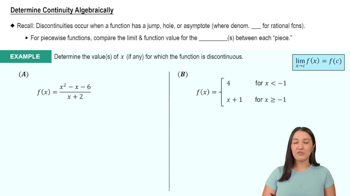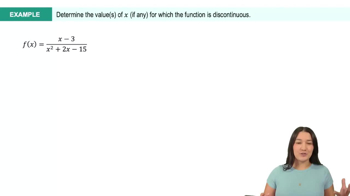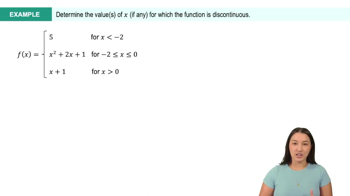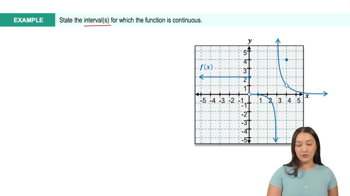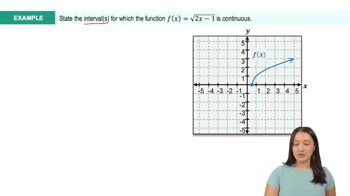Table of contents
- 0. Functions7h 52m
- Introduction to Functions16m
- Piecewise Functions10m
- Properties of Functions9m
- Common Functions1h 8m
- Transformations5m
- Combining Functions27m
- Exponent rules32m
- Exponential Functions28m
- Logarithmic Functions24m
- Properties of Logarithms34m
- Exponential & Logarithmic Equations35m
- Introduction to Trigonometric Functions38m
- Graphs of Trigonometric Functions44m
- Trigonometric Identities47m
- Inverse Trigonometric Functions48m
- 1. Limits and Continuity2h 2m
- 2. Intro to Derivatives1h 33m
- 3. Techniques of Differentiation3h 18m
- 4. Applications of Derivatives2h 38m
- 5. Graphical Applications of Derivatives6h 2m
- 6. Derivatives of Inverse, Exponential, & Logarithmic Functions2h 37m
- 7. Antiderivatives & Indefinite Integrals1h 26m
1. Limits and Continuity
Continuity
Problem 1b
Textbook Question
Which of the following functions are continuous for all values in their domain? Justify your answers.
b. n(t)=number of quarters needed to park legally in a metered parking space for t minutes
 Verified step by step guidance
Verified step by step guidance1
Step 1: Understand the function n(t). The function n(t) represents the number of quarters needed to park legally in a metered parking space for t minutes. This is a real-world scenario where the function outputs discrete values (whole numbers) based on the input time t.
Step 2: Consider the nature of the function. Since n(t) outputs the number of quarters, it is a step function. A step function is a piecewise constant function that jumps from one value to another without taking on any intermediate values.
Step 3: Analyze the continuity of step functions. A function is continuous at a point if there is no interruption or jump at that point. For step functions, there are jumps at certain points (e.g., when the number of quarters needed changes), which means they are not continuous at those points.
Step 4: Determine the continuity of n(t). Since n(t) is a step function, it is not continuous at the points where the number of quarters needed changes. These are the points where the function jumps from one integer value to another.
Step 5: Conclude about the continuity of n(t). Since n(t) is not continuous at the points where it jumps, it is not continuous for all values in its domain. It is only continuous within the intervals between these jumps.
Recommended similar problem, with video answer:
 Verified Solution
Verified SolutionThis video solution was recommended by our tutors as helpful for the problem above
Video duration:
2mPlay a video:
Was this helpful?
Related Videos
Related Practice





